Samsung DA-E750 Review
Samsung DA-E750
Exclusive: The world’s first dual docking audio system - for iPod/iPhones and Samsung Galaxy products.
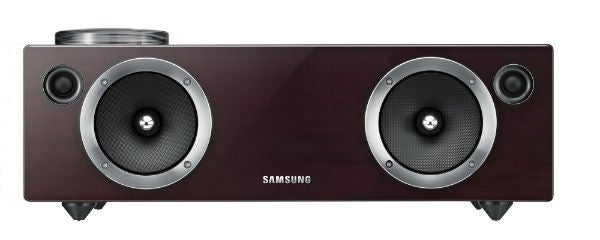
Verdict
Pros
- Crisp, fulsome sound
- Superb build quality and stunning design
- Excellent feature list
Cons
- Long-winded PC setup
- Won’t play FLAC, AAC or WAV
- Basic USB & iPod control
Key Specifications
- Review Price: £599.99
- Built-in dual Apple / Galaxy dock
- AirPlay and AllShare Play wireless streaming
- USB media playback
- Bluetooth 3.0 with apt-X CSR
- Built-in Wi-Fi
- Digital / vacuum tube amp
The DA-E750 is the world’s first dual docking audio system, designed to play music from Apple and Samsung Galaxy devices both wirelessly and through its built-in dock. It’s equipped with AirPlay, AllShare Play and Bluetooth 3.0, which already sounds pretty tempting, but with USB support and Samsung’s hybrid digital/valve amplifier also on board, it’s shaping up to be something special – find out how it fares in our exclusive review.
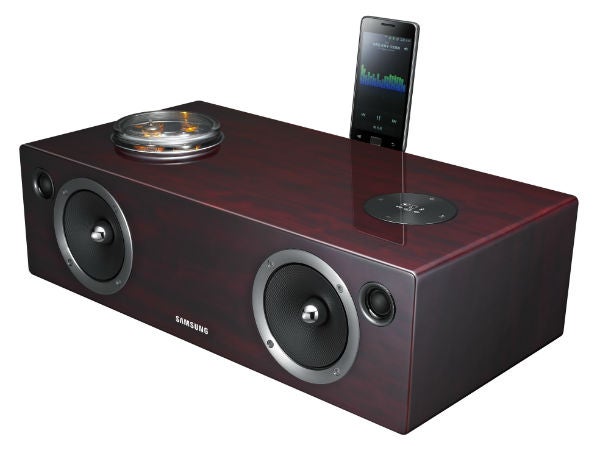
Design
Our first impressions after pulling the DA-E750 out of the box are overwhelmingly positive. The unit’s build quality is sheer luxury – it’s satisfyingly heavy, plus the Red Mahogany with hand-polished finish lends elegance and sophistication (likewise the alternative Black Mahogany Wood finish). The construction is easily on a par with other ‘high-end’ docks like the Monitor Audio i-deck and the B&W Zeppelin Air – it really is a beautifully made unit.
There are plenty of other aesthetic touches that make this dock stand out. The silver cone surrounds and phase plugs on the front panel bring a touch of glamour; the window showing the red-glowing valves is not only stylish but unique; and the round panel of controls on top is quirky yet practical. It’s a shame that there’s no display panel, but there’s a danger it might have ruined the minimal aesthetic.
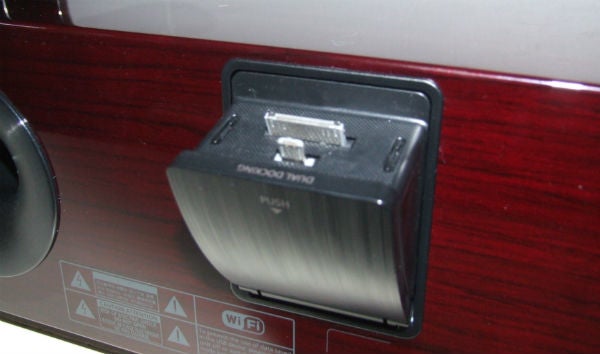
On the back is the hidden iPod/Galaxy dock. Putting it here is a clever move as it doesn’t clutter up the minimal front panel and keeps everything nice and clean. The sturdy dock opens with a smooth action, as opposed to the flimsy plastic trays you sometimes find on docks and home cinema systems. There’s a support that slides up and holds your device in place (particularly useful for iPads), which provides a steady base, and also in the box are spacer covers for the connector that’s not being used.
Connections
Also on the rear panel is a useful array of sockets. The USB port allows you to play media from storage devices, while the 3.5mm minijack input lets you connect other portable audio players.
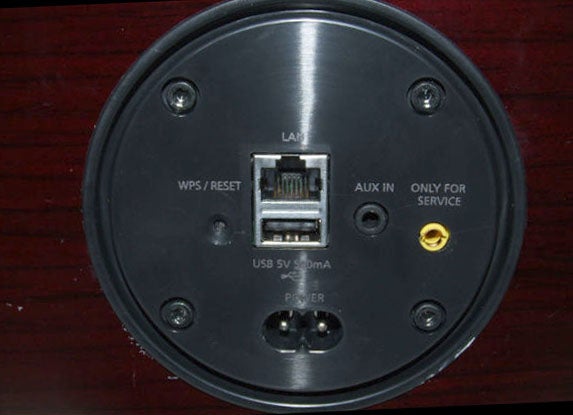
Despite having built-in Wi-Fi, the Ethernet port is still an important socket as many listeners prefer the stability of a wired connection when streaming large files. It also allows those without Wi-Fi to use the streaming features.
Features
The DA-E750 sets itself apart from the competition with an amazing range of features, several of which you won’t find anywhere else. The obvious highlight is the dual purpose dock that supports both Galaxy and Apple devices (Galaxy-S3, Note and Player; iPod, iPhone and iPad). That’s great if you have a combination of these devices in your household, as it means anyone can easily share their music out loud.
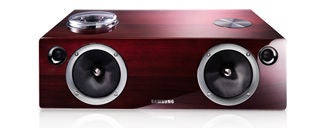
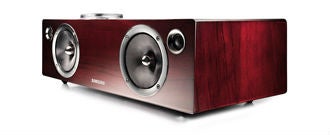
But this is primarily a wireless audio system, and as such you can stream music from Apple devices using AirPlay, or from Galaxy devices using AllShare Play. It even boasts the latest version of Bluetooth (3.0) with apt-X CSR to prevent the reduction in quality that normally occurs with A2DP-transmitted music.
The inclusion of AirPlay, AllShare and Bluetooth support means the user has a great deal of choice as to how they enjoy their music, and stands it in good stead against competition like the Bose SoundDock 10 and B&W Zeppelin Air, which can’t touch the DA-E750 on features.
The Bluetooth-enabled SoundShare mode is another useful feature, as it allows users to beam sound wirelessly from a Samsung TV to the dock. That’s a great way of boosting sound from a compatible flatpanel TV without having lots of cables trailing everywhere, or having to invest in a space-hogging home cinema system. Again, this isn’t something that many docking systems support and Samsung deserves credit for including it.
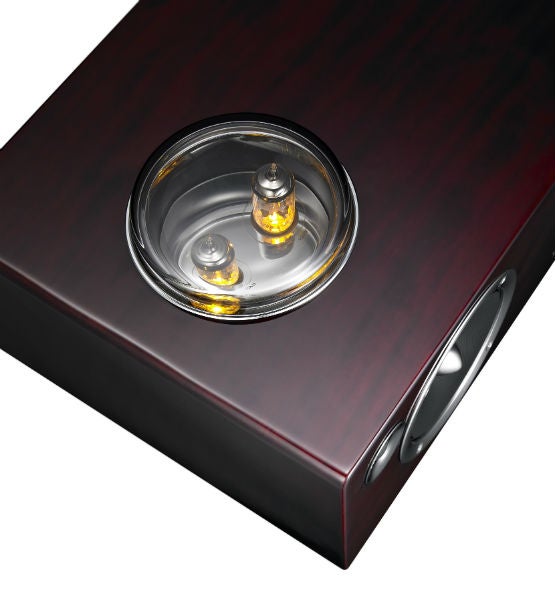
Another headline grabber is Samsung’s unique combination of digital and vacuum tube amp technology, designed to add warmth to the sound by building up even harmonics. On the HT-E6750W home cinema system this worked well, so we’re hoping for more of the same here.
The inclusion of a USB port is a key feature but the limited file support from USB devices is a disappointment. As expected the system plays MP3 and WMA, but the lack of FLAC, WAV and AAC compatibility isn’t likely to please audiophiles looking for the ultimate sound quality. It’s also a shame that the unit doesn’t support external hard-disk drives, as the ability to keep a large-capacity drive connected to the dock would have been a real bonus.
It’s also a shame that a premium system like this doesn’t offer radio functionality. The inclusion of a DAB tuner, for example, would have made the DA-E750 more of a complete audio solution. And it’s similarly disappointing to find no internet radio support given that there’s built-in Wi-Fi, which really would have been the icing on the cake. These would have driven up the cost, yet ‘high-end’ buyers might have been willing to pay a little more for features like these.
The DA-E750 boasts 2 x 20W of amplification, with a subwoofer built into the bottom of the unit providing 60W of bass oomph. The speaker cones are crafted from glass fibre with a phase plug in the middle. There’s a Bass mode that boosts low frequencies.
Operation
Basic operation of the DA-E750 is easy once you have familiarised yourself with the various icons on the top-mounted panel of controls. Toggling through the sources using the F. button, adjusting the volume or controlling playback is straightforward, although as mentioned it could have been easier with a display panel showing what you’ve selected – it’s impossible to tell from afar because the controls are placed on top.
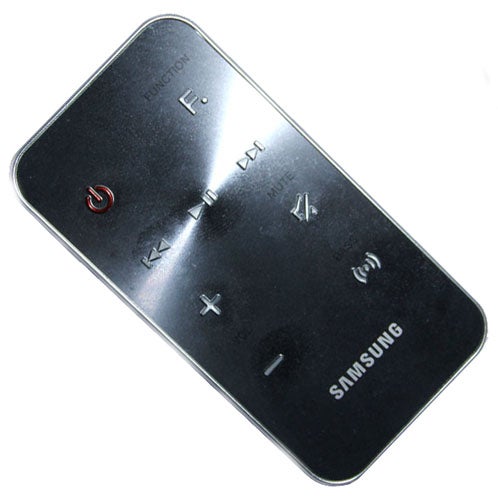
The small, ergonomic remote sports a sparse array of small buttons that give a satisfying click when pressed, all placed within easy reach of the thumb. What’s more, the aluminium finish and glossy back panel also give it real coffee table appeal.
Setting up the DA-E750 to work with an iPad or iPhone is simple, although without a front-panel display it’s not obvious – read the manual first. Connect the device to the dock, hold down the WPS/Reset button on the back and choose the ‘Allow’ option when it pops up on your device’s screen. Then switch to AirPlay mode and away you go.
Setting the dock up with a Windows laptop is more long-winded, but to be fair it’s a similar story with other wireless audio systems that don’t have a display panel, like the Monitor Audio i-deck and B&W Zeppelin Air.
To get the DA-E750 talking to your laptop, you have to hold down the WPS/Reset button and the dock’s name eventually appears in the list of access points on your laptop. Then you have to enter the DA-E750’s IP address and enter the relevant information on the setup screen that appears. Two things hindered this process – the Samsung’s name took an age to appear in the list of Wi-Fi APs, and our router took a similarly long time to pop up in the setup screen’s drop-down menu.
But it got there in the end and once completed we were able to link up our laptop with the DA-E750 and use AirPlay smoothly, taking advantage of the robust and reliable connection.
We also hooked up an iPod to the built-in dock and it reacted quickly to commands from the remote, although we’re surprised to find there’s no way of jumping back to the previous menu and browsing the library using the remote. The only commands available are skip forward/back and play/pause. So to find the music you want you have to use the iPod up close, which defeats the object of having a remote.
USB playback is similarly hit and miss. With no display, you can’t find particular tracks – the unit starts playing at whatever tune is first on the list, and only lets you skip through them. It’s fine if you just want to stick a bunch of tunes on at a party, but doesn’t feel as sophisticated as it should for such a cutting edge product.
Performance
Sound quality is generally impressive. With Amy Winehouse’s Lioness: Hidden Treasures streamed from iTunes via AirPlay, the DA-E750 musters a sound that’s best described as chunky. There’s a lovely depth and solidity to the low-end frequencies and midrange, no doubt a result of the vacuum tube amp at play inside. It’s punchy and robust, perfect for the hip-hop beats and pulsating bass of Half Time and Like Smoke. 
But this is complemented by a decent amount of high-frequency detail, allowing hi-hats, percussion, plucked guitars and the upper end of Winehouse’s distinctive voice to shine through. Individual elements are given plenty of room to breathe within the stereo image, and the listener isn’t overwhelmed by boomy bass.
Turn on the Bass mode and the overall sound is fuller and richer, giving songs even more presence than they had before, but there’s still an abundance of top-end detail and vocals are allowed to burst through unimpeded.
It’s also testament to the unit’s classy processing that it makes any source sound good, whether it’s playing tunes beamed from a phone via Bluetooth, or CDs from a portable player hooked up to the minijack input. We can’t fault the quality of MP3s played from USB or over a network either.
We would say, however, that the DA-E750 doesn’t quite reach the same levels of refinement and insight as other high-end docking systems like the Monitor Audio i-deck and B&W Zeppelin Air. The Monitor Audio in particular has a lightness of touch and a more convincing sense of openness and texture, which the Samsung struggles to emulate. That makes it a better bet if you’re into jazz or classical, genres with which the DA-E750 is a little heavy handed.
But that’s us talking with our audiophile hat on – most listeners will enjoy the DA-E750’s crisp and punchy sound, which puts the vast majority of speaker docks on the market to shame. This is a premium product in every sense of the word, with sound quality that befits its price tag.
Verdict
Although there’s room for improvement, the DA-E750 is an impressive audio system. First up, its design and build quality are simply stunning, with a look and feel that’s every bit as classy as you’d expect for the money. The gorgeous piano finish, the visible valve amp on top and the glimmering silver detail on the front give the unit a distinctive, distinguished look, all bolted together with the sort of care and robustness you’d normally get from an esoteric audiophile brand.
The DA-E750’s feature list is equally attractive, leaving its competitors standing with its dual Apple/Galaxy dock, support for AirPlay and AllShare Play and compatibility with the latest incarnation of Bluetooth. Throw USB playback, Samsung’s vacuum tube/digital amp and a built-in subwoofer into the mix and you’ve got one talented audio system.
On the downside, the limited format support (no FLAC or AAC) and lack of radio tuners are disappointing, as their inclusion could have turned this into an essential music epicentre. Network setup isn’t the most straightforward process either (not helped by the lack of a display panel) and USB playback is a guessing game.
But even when you take these drawbacks into consideration, we still think the DA-E750 deserves our recommendation by virtue of its excellent sound quality and killer features, many of which you won’t find on its high-end competitors.
Trusted Score
Score in detail
-
Design 9
-
Sound Quality 8
-
Features 8
-
Value 9
-
Usability 8
Storage
| Expandable memory | No |
Audio Codecs
| MP3 | Yes |
| Apple Lossless | No |
| AIFF | No |
| AAX | No |
| WAV | No |
| AAC | No |
Physical Specifications
| Weight (Gram) | 9000g |

